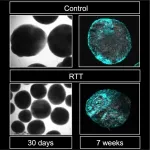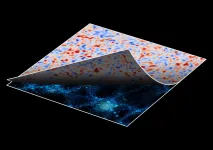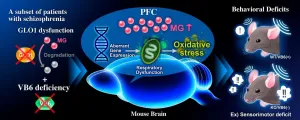Smart technology is not making us dumber
UC social/behavioral expert explains that tech doesn't dumb us down
2021-07-02
(Press-News.org) There are plenty of negatives associated with smart technology -- tech neck, texting and driving, blue light rays -- but there is also a positive: the digital age is not making us stupid, says University of Cincinnati social/behavioral expert Anthony Chemero.
"Despite the headlines, there is no scientific evidence that shows that smartphones and digital technology harm our biological cognitive abilities," says the UC professor of philosophy and psychology who recently co-authored a paper stating such in Nature Human Behaviour.
In the paper, Chemero and colleagues at the University of Toronto's Rotman School of Management expound on the evolution of the digital age, explaining how smart technology supplements thinking, thus helping us to excel.
"What smartphones and digital technology seem to do instead is to change the ways in which we engage our biological cognitive abilities," Chemero says, adding "these changes are actually cognitively beneficial."
For example, he says, your smart phone knows the way to the baseball stadium so that you don't have to dig out a map or ask for directions, which frees up brain energy to think about something else. The same holds true in a professional setting: "We're not solving complex mathematical problems with pen and paper or memorizing phone numbers in 2021."
Computers, tablets and smart phones, he says, function as an auxiliary, serving as tools which are good at memorization, calculation and storing information and presenting information when you need it.
Additionally, smart technology augments decision making skills that we would be hard pressed to accomplish on our own, says the paper's lead author Lorenzo Cecutti, a PhD candidate at the University of Toronto. Using GPS technology on our phones, he says, can not only help us get there, but lets us choose a route based on traffic conditions. "That would be a challenging task when driving round in a new city."
Chemero adds: "You put all this technology) together with a naked human brain and you get something that's smarter...and the result is that we, supplemented by our technology, are actually capable of accomplishing much more complex tasks than we could with our un-supplemented biological abilities."
While there may be other consequences to smart technology, "making us stupid is not one of them," says Chemero.
INFORMATION:
The paper's co-authorship includes Spike W.S. Lee, University of Toronto.
[Attachments] See images for this press release:

ELSE PRESS RELEASES FROM THIS DATE:
2021-07-02
A new study disputes the prevailing hypothesis on why Mercury has a big core relative to its mantle (the layer between a planet's core and crust). For decades, scientists argued that hit-and-run collisions with other bodies during the formation of our solar system blew away much of Mercury's rocky mantle and left the big, dense, metal core inside. But new research reveals that collisions are not to blame--the sun's magnetism is.
William McDonough, a professor of geology at the University of Maryland, and Takashi Yoshizaki from Tohoku University developed a model showing ...
2021-07-02
Ibaraki, Japan - The flavor of a tomato is an interaction between its taste and aroma. Now, researchers from Japan and the United States have revealed that the pigments that determine the colors of tomatoes also affect their flavor.
In a study published this month, researchers from University of Tsukuba developed a new method to rapidly measure the pigment profiles of tomatoes and used the technique to explore how pigments affect the taste and aroma of different tomato varieties.
The color of tomatoes is produced by combinations of different types of pigments, including carotenoids and chlorophylls. These pigments can also affect the accumulation of flavor-related compounds such as sugars, which affect the taste of tomatoes, and volatile ...
2021-07-02
A surprising study by UNSW on the behaviour of unrelated lizards in very different parts of the world has demonstrated how evolution can lead to different species learning the same skills.
The study in Ecology Letters documents how the Anolis lizard species in the Caribbean, and the Draco lizard species in Southeast Asia, have solved the challenge of communicating with one another to defend territories and attract mates.
It found males from both species perform elaborate head bob and push up displays, and rapidly extend and retract their often large and conspicuously coloured dewlap, or ...
2021-07-02
The muskrat, a stocky brown rodent the size of a Chihuahua - with a tail like a mouse, teeth like a beaver and an exceptional ability to bounce back from rapid die-offs - has lived for thousands of years in one of Earth's largest freshwater deltas, in northeastern Alberta, Canada.
Today, this delta lies within one of the largest swaths of protected land in North America: a national park five times the size of Yellowstone that's home to the planet's biggest herd of free-roaming bison and the last natural nesting ground for the endangered whooping crane. It's also central to the culture ...
2021-07-02
Guadalupe fur seals (Arctocephalus townsendi) have established a large resting colony in the Gulf of California--bringing the total number of sites where this endangered species now occurs to just four. This new haul-out was discovered on El Farallón de San Ignacio Island, along the mainland coast of Mexico, according to researchers from Mexico and the University of British Columbia.
Guadalupe fur seals were hunted for their furs and declared extinct in the late 1800's. However, 14 individuals were discovered on Guadalupe Island in 1950--and the population has grown since then. While still designated as vulnerable to extinction, according to IUCN, the population is believed to total 41,000 individuals and is growing ...
2021-07-02
In an Australian world-first, researchers have successfully repurposed two existing medications to reduce the severity of sleep apnoea in people by at least 30 per cent.
Affecting millions around the world, sleep apnoea is a condition where the upper airway from the back of the nose to the throat closes repetitively during sleep, restricting oxygen intake and causing people to wake as often as 100 times or more per hour.
Those with untreated sleep apnoea are more likely to develop cardiovascular disease, dementia and depression, and are two to four times more likely to crash a car than the general population.
Despite almost thirty years of research, there are no approved drug therapies to treat the condition.
Professor Danny Eckert, Principal ...
2021-07-02
Fukuoka, Japan--Medical researchers led by Kyushu University have revealed a possible underlying genetic pathway behind the neurological dysfunction of Rett syndrome. The team found that deficiencies in key genes involved in the pathology triggers neural stem cells to generate less neurons by producing more astrocytes--the brain's maintenance cells.
The researchers hope that the molecular pathology they identified, as reported in the journal Cell Reports, can lead to potential therapeutic targets for Rett syndrome in the future.
Rett syndrome is a progressive neurodevelopmental disorder characterized by impairments in cognition and coordination--with varying severity--and occurs in roughly one in every 10,000 to 15,000 female births. However, it ...
2021-07-02
Japanese astronomers have developed a new artificial intelligence (AI) technique to remove noise in astronomical data due to random variations in galaxy shapes. After extensive training and testing on large mock data created by supercomputer simulations, they then applied this new tool to actual data from Japan's Subaru Telescope and found that the mass distribution derived from using this method is consistent with the currently accepted models of the Universe. This is a powerful new tool for analyzing big data from current and planned astronomy surveys.
Wide area survey data can be used to study the large-scale structure of the Universe through measurements of gravitational lensing patterns. In gravitational lensing, the ...
2021-07-02
Microorganisms produce natural products, for example, as disease-causing virulence factors or as defense substances against predators and competitors. A team led by Dr. Robin Teufel and first author Ying Duan from the Institute of Biology II at the Faculty of Biology of the University of Freiburg, together with researchers from the University of Bonn, have now discovered a novel enzyme that is crucial for the production of so-called bacterial tropone natural products. The researchers presented their results in the current issue of the Journal of the American Chemical Society.
Previously unknown enzyme type
Bacteria found in terrestrial and marine environments produce tropone natural products, among other things, when they interact symbiotically with plants, algae or lower animals, for ...
2021-07-02
Methylglyoxal (MG) is a highly reactive α-ketoaldehyde formed endogenously as a byproduct of the glycolytic pathway. MG accumulates under conditions of hyperglycemia, impaired glucose metabolism, or oxidative stress. An excess of MG formation causes mitochondrial impairment and reactive oxygen species (ROS) production that further increases oxidative stress. It also leads to the formation of advanced glycation end products (AGEs) due to MG reacting with proteins, DNA, and other biomolecules, which can induce aberrant inflammation via binding to receptors for AGEs (RAGE). To remove the toxic MG, ...
LAST 30 PRESS RELEASES:
[Press-News.org] Smart technology is not making us dumber
UC social/behavioral expert explains that tech doesn't dumb us down






